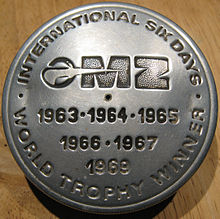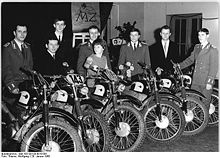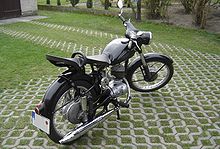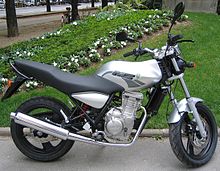- MZ Motorrad- und Zweiradwerk
-
MZ Motorrad- und Zweiradwerk GmbH 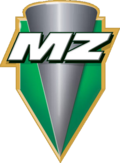
Industry Motorcycle Founded 1906 Founder(s) Jørgen Skafte Rasmussen Headquarters Zschopau, Germany Website muz.de MZ Motorrad- und Zweiradwerk GmbH is a motorcycle manufacturer located in Zschopau, Germany. MZ an acronym, stands for Motorradwerk Zschopau (German for motorcycle factory at Zschopau) in the Erzgebirge region of Saxony. From 1992 to 1999 the company was called MuZ, an acronym for Motorrad und Zweiradwerk (German for motorcycle and two-wheeler factory).
Contents
History
- 1906 Jørgen Skafte Rasmussen (Denmark) bought an empty cloth factory in Zschopau
- 1917 invented the Dampf-Kraft-Wagen (DKW) (German for steam-powered car) also known by its trademark DKW
- 1920 motor-assisted bicycle.
- 1923 renamed in DKW
- 1927 started racing activities
- 1928 DKW takes over the Audi factory at Zwickau
- 1929 60,000 motorcycles leave the Zschopau factory, and DKW is the largest motorcycle manufacturer in the world
- 1931 introduced DKW small cars
- 1932 The Auto Union was founded, created from Audi, Horch, Wanderer and DKW.
- 1939 developed the RT 125
- 1948 renamed in IFA (a state-owned enterprise in GDR)
- 1950 The Zschopau works begins production of the RT 125 model, developed before the war, under the trademark IFA (Industrieverwaltung Fahrzeugbau). This model became patent free after the war as part of war reparations [1] and was further developed in Britain (BSA Bantam), USA (Harley-Davidson Hummer), Russia (M-1A Moskva), Japan, Italy and West Germany.
- 1952 the BK350 appears, the first two-stroke shaft drive.
- 1956 The works is now called VEB Motorradwerk Zschopau, or MZ for short.
- 1962 The ES 125 / ES 150 starts manufacturing. Up to the present day (2004) it is the most-built German motorcycle.[citation needed] It was also the first motorcycle with an asymmetric low beam headlight pattern.
- 1970 the millionth motorcycle rolls off the conveyor belt, an MZ ETS 250 Trophy Sport
- 1972 MZ takes over manufacturing of sidecars from Stoye.
- 1983 the 2-millionth motorcycle rolls off the conveyor belt, this time an MZ ETZ 250. With disk brakes and 12-volt electrics the MZ had reached the modern standard in motorcycle design.
- 1989 MZ ceases manufacture of sidecars.
- 1990 MZ is privatised, on 18 December.
- 1993 MZ goes under receivership, and the ETZ patent sold to the Turkish firm Kanuni which continued producing models 251 and 301. The MuZ company is formed from the rest.
- 1996 MuZ was bought by the Malaysian Corporation Hong Leong Group
- 1999 the u is finally dropped from the name MuZ.
- 2008 On 9 June, Motor Cycle News reported that MZ is to cease operations at the end of 2008 because the company's Malaysian backers withdrew their financial support after years of continuing losses.
- 2008 On 12 December, the MZ factory in Zschopau closed.[2] bringing a halt to motorcycle production that had lasted for 88 years in the same town. The old 'East German' factory became a night club, called MZWerk.[3]
- 2009 Former GP stars Ralf Waldmann and Martin Wimmer buy the MZ motorcycle brand. The deal went through on 23 March 2009 for a reported four or five million euros. The cash is being put up by the Hong Leong Group. The new board will consist Ralph Waldmann, Martin Wimmer, Dr Martin Hager, Helmut Lichtenberg and Otto Elbers. Wimmer will take over the role of MZ Managing Director with immediate effect. There are rumours that the firm is going to produce a 600 cc road bike based on the Moto2 GP project bike.[4][5]
The Zschopau works was one of the oldest motorcycle factories in the world, producing motorcycles since 1922. The most well known models were the two-stroke 125/150 and 250 series, with the variants ES, ETS, TS und ETZ. MZ was one of the few producers that made motorcycles with sidecars, though prior to 1972 sidecars were manufactured by Stoye.
Sports
Activities started in 1927
Enduro
Winner of International Six Day Trial: 1963, 1964, 1965, 1966, 1967, 1969, 1987.
Road Racing
- 1958 first wins in 125/250 cc and an over all second championship 250 cc
- The MZ two-stroke engines, developed by engineer Walter Kaaden, have influenced motorcycle racing for decades. His 1961 125 cc race engine design was the first to achieve an output of 200 bhp (150 kW) per litre.[1] His revolutionary two-stroke system was copied widely in the 1960s by Japanese manufacturers. Yamaha and Suzuki two-stroke engines became competitive in motor sport only after they gained possession of MZ design secrets. MZs were ridden to 13 GP victories and 105 rostrum places between 1955 and 1976.[6]
The East German government did not support the international racing aspirations of MZ. The defection to the West of grand prix rider Ernst Degner, complete with his theft of a set of secrets, started the end of the glory years of Kaadens bikes.
- The MZ Skorpion Sport 660 cc single got its own MuZ-cup racing series in several countries at the end of the nineties. It is famous for its precise handling. It is still a popular mount for club racing and Supermono racing.
The Yamaha-based engine can be reliably tuned to 150 percnt of its original performance. At that stage, it can become competitive in Supermono racing classes and in single and twin-cylinder racing classes.
- The MZ ETZ 250 and 251 is currently being used in club racing around Britain, providing budget racing for those who want to race with all of the fun but less of the expense. The home of MZ racing is the BMZRC or British M Z Racing Club.
Notable models
- RT 125: 1939–1962 and 2000-today
- ES250 : Utilized a pressed steel body with Earles type front suspension.
- ETS250 : Sports version of the ES but with more traditional type of tank and telescopic forks. The distinctive 5 imperial gallons (23 l; 6.0 US gal) fuel tank makes this model a desirable classic motorcycle.
- TS125/150 : Direct descendants of the RT125, and the last MZs to use "premix" fuel and a 6-volt electrical system.
- TS250: Developed from the ES/ETS machines but with a new frame. The engine hung from the top beam pivoting at the rear with no front down tube. Early models were four-speed machines with the vertical finned cylinder head but the later machines had the flat top engine and five-speed gear box, the basis of the later models. These models were all 6-volt and pre-mix fuel.
- ETZ250 : The first road going MZ to include a disk front brake and automatic oil injection. There has been a special model ETZ250A which equipped the GDR's army and has been exported to several countries of the former east block.
- ETZ251 : Derived from the ETZ250 but with modifications to the motor and chassis. A 300 cc version was also marketed.
- ETZ125/150 : Similar to the ETZ251 in appearance but with an updated 125/150 motor, now with the flat-topped cylinder head, five-speed gearbox and autolube. The design of the engine was still derived from the original DKW design, apparent from the concentric kick start and gear lever arrangement.
- 500R : MZ's first four-stroke motorcycle, essentially an ETZ251 with a Rotax 500 cc engine fitted, although the engine was no longer rubber mounted and a front down tube provided extra support.
- MZ Skorpion [7]: The 500 cc Rotax engine used on the Seymour-Powell designed prototype was replaced with a 660 cc Yamaha water-cooled engine on the production vehicle.
- 1000S [8]: MZ's biggest bike, and their first "in-house" four-stroke engine.
Most recent models
MZ manufactured a line of 125 cc four-stroke motorcycles using an engine that was designed in-house. The MZ 125 produces 15 bhp (11 kW) and nearly 10 lb·ft (14 N·m) of torque. It is a liquid-cooled, dual-overhead-cam design with four valves, high-voltage electronic ignition and an 11,000 rpm ignition cut-off. This engine was used in four models, all of which share a common frame. The frame is a tube-steel backbone with the engine as a stressed bottom member. Differences in the suspension, fascia, gearing, and equipment make the four models relatively distinct, despite the shared platform. All four bikes feature a six-speed transmission and dual disc brakes.
- The RT-125 is a mini naked sport bike introduced in 2000. It features a 125 cc liquid-cooled DOHC single-cylinder engine, developing 15 bhp.
- The 125-SM is a Supermotard style bike with taller street tuned suspension, tallish gearing, and reduced weight.
- The 125-SX features the same appearance as the SM but has a suspension tuned more for off-road use, enduro-style tires, and slightly lower gear ratios.
- The 125 FunX is a minimalist light-duty motocross bike.
All four 125s are capable of speeds over 65 mph (105 km/h), with the fastest being the RT and SM, both of which are capable of 75 mph (121 km/h) sustained speeds.
MZ also used a Yamaha-built 660 cc single in the Baghira line of mid-displacement Enduro/DualPurpose/Motard bikes.
The last new MZ model was the 1000S which featured a novel 1000 cc, DOHC parallel twin designed and built by MZ. The 1000S is a sport-tourer by design. The 1000S' unique engine is exceptionally compact for its displacement. The range includes a naked (unfaired) version and a full tourer with luggage, higher handlebars, and lower footpegs for comfort. Both of these are retuned, with less outright horsepower than the 'S', but with more torque.
In addition to the 1000S, MZ also produced the naked version of the 1000S, known as the 1000SF, and the sports touring version known as MZ1000ST. MZ also produces its own lines of scooters known as MZ Moskito, powered by a 50 cc two-stroke engine.
Besides scooters, MZ also produced its own line of underbone motorcycles, targeted for the Southeast Asian market. Their debut underbone model was the MZ Perintis 120, launched in 2002. The Perintis was succeeded by the MZ Mantizz series, launched in 2004 – the design of which is based on their flagship 1000S model. The Mantizz series has two displacement options – 125 cc and 110 cc. All MZ underbone models are powered by four-stroke engines and are manufactured in MZ's Malaysian plant in Shah Alam.
MZ also competed in the European GP-500 class with race-only models, and built several scooter and ATV models ranging in displacement from 50 cc to 185 cc, as well as the Charlie electric scooter, the fastest stand-up electric scooter produced.
As of January 2010 only the Charlie electric scooter, is in production and the company is under new owners.
References
- ^ a b Halcyon days: MZ a potted history Alan Turner, Motorcycle Sport and Leisure, No. 577 October 2008, pp.114–118
- ^ "Famed East German MZ motorcycle factory to close". Thelocal.de. http://www.thelocal.de/society/20090106-16577.html. Retrieved 2010-12-20.
- ^ "MZWerk' night club in the old factory". Mzwerk.de. http://www.mzwerk.de/. Retrieved 2010-12-20.
- ^ "Waldmann MZ buyout confirmed – Motorcycle news : General news". Visordown. 2009-03-25. http://www.visordown.com/motorcyclenews/view/waldmann_mz_buyout_confirmed/6607.html. Retrieved 2010-12-20.
- ^ "Motorenwerke Zschopau". Muz.de. http://www.muz.de/. Retrieved 2010-12-20.
- ^ MZ – the racers by Jan Leek, 650 Publications, 1991, ISBN1-872982-01-8
- ^ http://www.motorcyclenews.com/MCN/bikereviews/searchresults/Bike-Reviews/MZ/MZ-Skorpion-660-1994-03/
- ^ http://www.motorcyclenews.com/MCN/bikereviews/searchresults/Bike-Reviews/MZ/MZ1000S-2004---current/
Further reading
- Leek, Jan (1991), MZ – the racers, 650 Publications, ISBN 1872982018
- Oxley, Mat (2010), Stealing Speed: The Biggest Spy Scandal in Motorsport History, Haynes Publishing Group, ISBN 1844259757
- Walker, Mick (2004), MZ, Redline Books, ISBN 0954435745
- Woll, Manfred, IFA/MZ Renngeschichte1949-1961, ISBN 3-89880-011-3
External links
- Official site
- The Long History of Reverse-Cylinder Engine Designs – motocrossactionmag.com
- MZ MuZ at the Open Directory Project
Major and Notable German motorcycle marques Categories:- Motorcycle manufacturers of Germany
- Sidecars
- MZ motorcycles
- Industrieverband Fahrzeugbau
Wikimedia Foundation. 2010.

